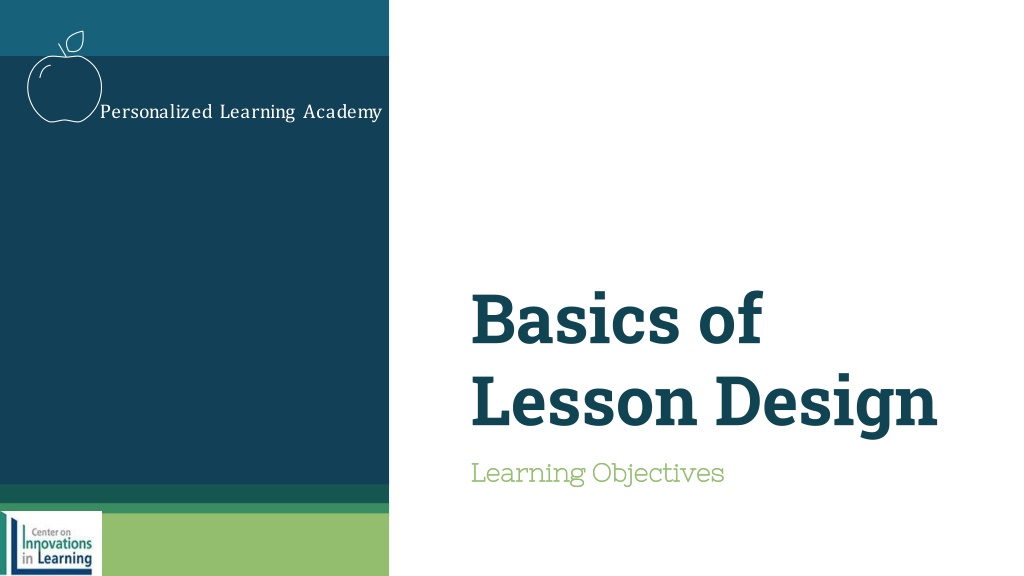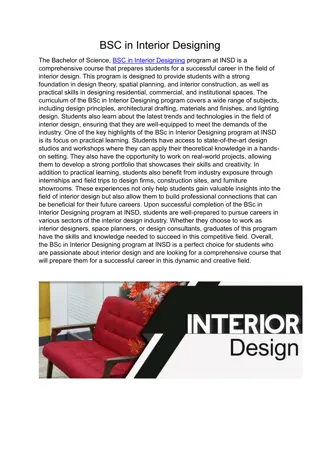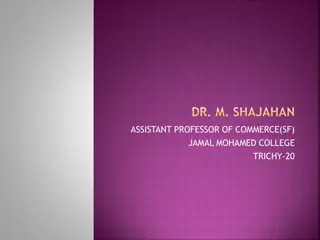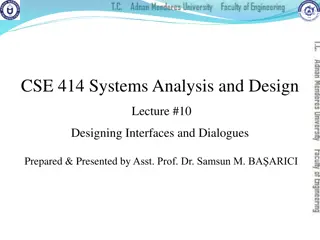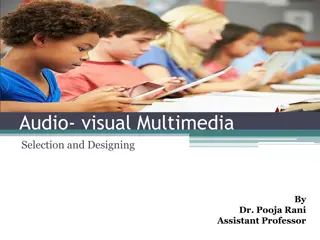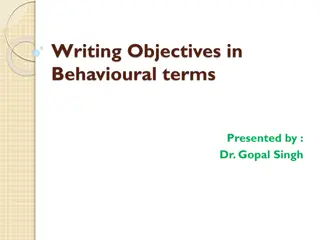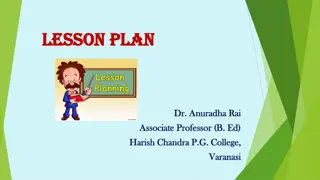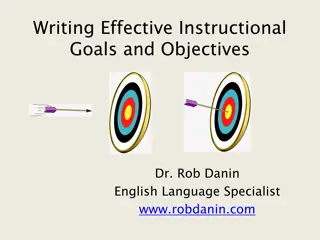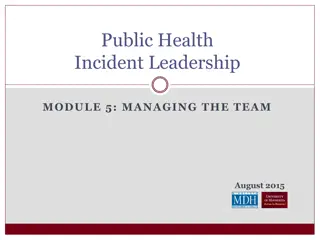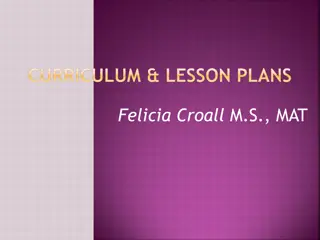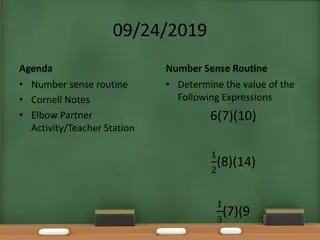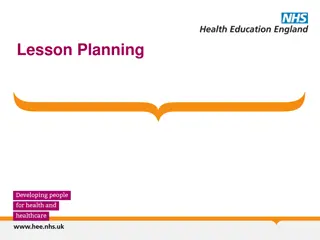Basics of Designing Effective Lesson Objectives
Developing successful lessons requires integrating key components like objectives, activities, and strategies. This involves setting clear learning objectives, designing activities to support learning, and using strategies to assess understanding. By focusing on specific learning objectives, educators can tailor their lessons to address student needs effectively.
Download Presentation

Please find below an Image/Link to download the presentation.
The content on the website is provided AS IS for your information and personal use only. It may not be sold, licensed, or shared on other websites without obtaining consent from the author. Download presentation by click this link. If you encounter any issues during the download, it is possible that the publisher has removed the file from their server.
E N D
Presentation Transcript
Personalized Learning Academy Basics of Lesson Design Learning Objectives Learning Objectives
A successful lesson addresses and integrates 3 key components: Text Title Text Title Place your own text here Objectives Objectives for student learning Activities Activities for teaching and learning Strategies Strategies to check student understanding 1 1 2 2 3 3
Objectives Objectives for student learning 1 1 Choose the standard to address ELA-L. W. 3.2: Write informative/explanatory texts to examine a topic &convey ideas &information clearly. Write the objective for the lesson (the learner and behavior) The students will be able to Write the condition conditions for mastery of the objective When this then that when conditions are met Write the criteria for mastery
Writing Lesson Objectives Learner/Behavio Learner/Behavio r r (the who/what) Criterion Criterion (the extent) Condition Condition (the how) Let s Practice (get your Response Cards ready- Add Yes & No)
Lesson Objectives Lesson Objectives for student learning 1 1 A ten-year-old boy wants to join you on your sailboat and insists that he knows how to swim. You'd like to be sure, because you tip over frequently How much faith would you have in his claim on the basis of the following examples of evidence?
Lesson Objectives Lesson Objectives for student learning 1 1 A. You ask him to tell you how to swim, and he says "I move my arms and kick my legs, while breathing over my shoulder. B. You ask him to demonstrate how he swims in your living room. On the rug, he waves his arms and kicks his legs, gulping air over his shoulder. C. You take him to a pool where he jumps in the deep end and swims to the other side. C A Which is best? Which is worst?
Lesson Objectives Lesson Objectives for student learning 1 1 If a Red Cross instructor told you that everyone who gets through her course will "know how to swim," you have some idea of what will happen during instruction and of how they will be tested. They would swim. Paddling around in water is an observable behavior which may indicate swimming. BUT, is it the best way to test learners and judge their ability? could ask about the test or their ability? What are some other questions you
Lesson Objectives Lesson Objectives for student learning 1 1 What are some other questions you could ask about the test and their ability? How far must they swim? How long must they swim? How deep will the water be? How turbulent will the water be? How fast must they swim? Must they swim with good form or simply get there?
Lesson Objectives Lesson Objectives for student learning 1 1 An objective should contain information about the: How turbulent will the water be? What kinds of problems will the learner solve? What kinds of tools will be provided? How well do we want the learner to do? Is speed important? What level of accuracy must be achieved?
Lesson Objectives Lesson Objectives for student learning 1 1 For instance, here are two different CONDITIONS for a scout trying to build a fire: CONDITIONS "With the equipment in the emergency kit "With the equipment in the emergency kit (matches, knife, but no paper) the scout will get a (matches, knife, but no paper) the scout will get a fire going on a wet day." fire going on a wet day." "With no matches, the scout will get a fire going "With no matches, the scout will get a fire going in a dry pine forest." in a dry pine forest." Should the scout practice the same things to meet both objectives? Yes or No? No
Lesson Objectives Lesson Objectives for student learning 1 1 Here are two different CRITERIA in a physical education course: CRITERIA we might impose "The learner will be able to do 150 sit "The learner will be able to do 150 sit- -ups without a break." a break." ups without "The learner will be able to demonstrate perfect "The learner will be able to demonstrate perfect form in 5 consecutive sit form in 5 consecutive sit- -ups. ups. Would you practice the same things if you were trying to meet both objectives? No? Yes or No
Lesson Objectives Lesson Objectives for student learning 1 1 Which objective is more clear about the CRITERION CRITERION for scoring the student's answer? A. The student will weigh a set of objects to within one milligram B. The student will weigh a set of objects accurately A
Lesson Objectives Lesson Objectives for student learning 1 1 The coach of a champion university swimming team is recruiting. The coach's goal (to win) is quite different from the Red Cross instructor's (to provide sufficient skill so that learners can reach shore safely). Suppose a swimmer who tries to join the swim team, and meets this objective .
Lesson Objectives Lesson Objectives for student learning 1 1 In calm water at least 7 feet deep, the swimmer can swim 100 yards without swallowing any water. Would a coach be satisfied with those CONDITIONS? Are they realistic for a team? Yes Yes or No? Would the coach be satisfied with the CRITERIA? Are they good enough for participation on the team? Yes or No? No, speed would be important. Ex: "In a standard pool, swim 100 meters in one minute.
Lesson Objectives Lesson Objectives for student learning 1 1 Suppose you are in charge of life guards at St. Thomas or St. John beach where the surf may consist of 8-foot waves. What major change would you make in the CONDITION CONDITION to specify what you would want in a life guard? In calm water at least 7 feet deep, the swimmer can swim 100 yards without swallowing any water. A A. In heavy surf B. On sunny days C. Riding a wave D. Near shore
Lesson Objectives Lesson Objectives for student learning 1 1 An engineering teacher states the following objective: "Without the use of a pocket calculator or a slide "Without the use of a pocket calculator or a slide- -rule, the engineer will calculate the stresses in at least 70% of the cases engineer will calculate the stresses in at least 70% of the cases given, given, across across various construction designs." various construction designs." rule, the We have a CONDITION CONDITION: without the use of those aids, and the CRITERION CRITERION: in at least 70% of the cases given. If you were hiring this engineer to build a bridge, would you consider the engineer competence? Yes or No? No No Is the CONDITION realistic? Yes or No?
Lesson Objectives Lesson Objectives for student learning 1 1 An objective that provides all pieces of information can still be UNCLEAR. For example: The child will read correctly any printed The child will read correctly any printed material written at the third material written at the third- -grade level. grade level. "Correctly" is a common CRITERIA. Is it clear to you?Material written at the third-grade level" is the CONDITION. Is it clear what will be read? How could we improve this objective? How could we improve this objective?
Writing Lesson Objectives Learner/Behavio Learner/Behavio r r Condition Condition Criterion Criterion Are these clear lesson objectives? (Choral Responding. Let s get 5 consecutive correct.)
Lesson Objectives Lesson Objectives for student learning 1 1 The student will comprehend what he reads. The student will comprehend what he reads. No 1. Is the learner/behavior clear? No, it s missing. No, it s missing. 2. Is the condition clear? 3. Is the criteria clear?
Lesson Objectives Lesson Objectives for student learning 1 1 When presented with long division problems When presented with long division problems involving whole involving whole- -number divisors number divisors & remainders remainders, , the student will the student will use a calculator to determine determine the quotient correctly in the quotient correctly in 9 out of 10 problems. problems. & no no use a calculator to 9 out of 10 Yes 1. Is the learner/behavior clear? Yes 2. Is the condition clear? Yes 3. Is the criteria clear?
Lesson Objectives Lesson Objectives for student learning 1 1 When presented with long When presented with long- -division problems involving whole involving whole- -number divisors and no number divisors and no remainders, the student will calculate the remainders, the student will calculate the quotient correctly in 95% of the problems. quotient correctly in 95% of the problems. division problems Yes 1. Is the learner/behavior is clear? Yes No 2. Is the condition clear? 3. Is the criteria clear?
Lesson Objectives Lesson Objectives for student learning 1 1 Given the personal pronouns Given the personal pronouns (I (I, , you, he, she, it, they, we) will they, we) will be able to form the contraction with be able to form the contraction with the appropriate form of the verb be." the appropriate form of the verb be." you, he, she, it, No 1. Is the learner/behavior is clear? Yes No 2. Is the condition clear? 3. Is the criteria clear?
Lesson Objectives Lesson Objectives for student learning 1 1 The student typist will spell all words correctly The student typist will spell all words correctly when typing from a dictaphone recording. when typing from a dictaphone recording. Yes 1. Is the learner/behavior is clear? No No 2. Is the condition clear? 3. Is the criteria clear?
Lesson Objectives Lesson Objectives for student learning 1 1 The test items will be presented on tape. Given 25 The test items will be presented on tape. Given 25 sentences, each containing at least one of the 100 sentences, each containing at least one of the 100 most common spelling errors (as listed in Prof. most common spelling errors (as listed in Prof. Ima Ima Speller's text), the secretarial student will Speller's text), the secretarial student will type each of the sampled words correctly. type each of the sampled words correctly. Yes 1. Is the learner/behavior is clear? Yes 2. Is the condition clear? Yes 3. Is the criteria clear?
Remember: A successful lesson plan addresses and integrates 3 key components: Text Title Text Title Place your own text here Objectives Objectives for student learning Activities Activities for teaching and learning Strategies Strategies to check student understanding 1 1 2 2 3 3 Later we ll cover the other 2.
